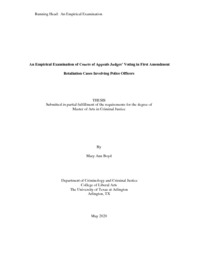
ATTENTION: The works hosted here are being migrated to a new repository that will consolidate resources, improve discoverability, and better show UTA's research impact on the global community. We will update authors as the migration progresses. Please see MavMatrix for more information.
Show simple item record
| dc.contributor.advisor | Wasserman, Lewis M | |
| dc.creator | Boyd, Mary Ann | |
| dc.date.accessioned | 2022-07-14T13:08:08Z | |
| dc.date.available | 2022-07-14T13:08:08Z | |
| dc.date.created | 2020-05 | |
| dc.date.issued | 2020-05-13 | |
| dc.date.submitted | May 2020 | |
| dc.identifier.uri | http://hdl.handle.net/10106/30675 | |
| dc.description.abstract | Abstract
The impact of judicial ideology on voting in First Amendment decisions has been the subject of many empirical investigations in U.S. Courts of Appeals and District Courts. However, little attention has been devoted to studying how ideology impacts voting in First Amendment retaliation claims brought by law enforcement officers against their departments. This study is designed to fill this gap in the literature.
Judges must consider and balance the right of public employees to exercise individual self-expression and autonomy while also safeguarding the rights of public institutions that provide necessary services to the public (Tsesis, 2015). Often the lines can become blurred when a public employees’ right to free speech causes disruption to the public employer’s mission, impeding its ability to provide services. Police officers take an oath to uphold the law yet when faced with having to report a superior or fellow officer for misconduct, these “whistleblowers” are often the ones who are ostracized and or punished. In 2006 the Supreme Court in Garcetti v. Ceballos appeared to cut back on plaintiffs’ First Amendment expressive rights growing out of their employment.
To investigate the impact of judicial ideology, as measured by party-of-the appointing president and the Garcetti decision on judicial voting in claims brought by law enforcement officers against their departments 109 U.S. Courts of Appeals decisions were studied involving a total of 327 judicial votes. Because the dependent measure selected was dichotomous [pro-plaintiff or pro-defendant vote] binary logistic modeling was applied to the data set. The principal independent variables under study were judicial ideology (whether the judge was appointed by a Republican or Democratic president) and legal precedent (whether the decision was made pre or post Garcetti). Other variables included in the equation were judges’ gender, prior prosecutorial experience, years on the bench, judges’ age, and judges’ race.
The logistic regression analyses revealed as predicted that judges’ ideology had a significant impact on Courts of Appeals judges’ voting (Wald=6.399, df =1, p=.011). Democratic judges were 1.871 times more likely to vote in favor of the First Amendment plaintiff than the Republican judges. Unexpectedly, judicial voting during the pre and post Garcetti time frames did not differ significantly from one another. The latter result was discussed in terms of why overall, judges might be more deferential to decisions made by law enforcement agencies in their application of the Garcetti decision. These reasons included the quasi-military organization of law enforcement agencies, concerns about public safety and the disruptive effect judges might anticipate occurring if they intervened in employment decisions made by police departments. | |
| dc.format.mimetype | application/pdf | |
| dc.language.iso | en_US | |
| dc.subject | First amendment | |
| dc.subject | Retaliation | |
| dc.subject | Whistleblower | |
| dc.subject | Public employees | |
| dc.subject | Police officers | |
| dc.subject | Courts of appeals | |
| dc.title | An Empirical Examination of Courts of Appeals Judges’ Voting in First Amendment Retaliation Cases Involving Police Officers | |
| dc.type | Thesis | |
| dc.date.updated | 2022-07-14T13:08:08Z | |
| thesis.degree.department | Criminology and Criminal Justice | |
| thesis.degree.grantor | The University of Texas at Arlington | |
| thesis.degree.level | Masters | |
| thesis.degree.name | Master of Arts in Criminology and Criminal Justice | |
| dc.type.material | text | |
Files in this item
- Name:
- BOYD-THESIS-2020.pdf
- Size:
- 500.5Kb
- Format:
- PDF
This item appears in the following Collection(s)
Show simple item record


